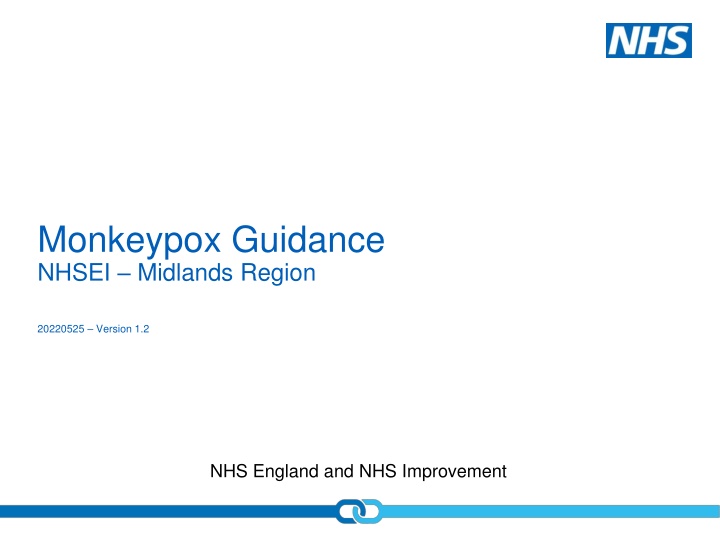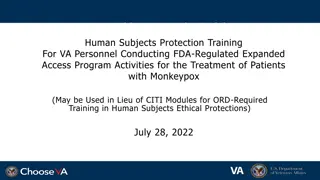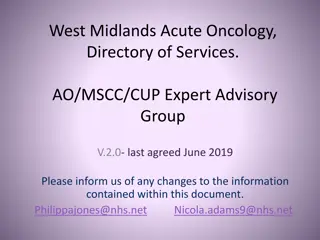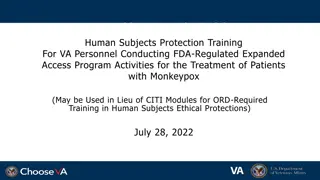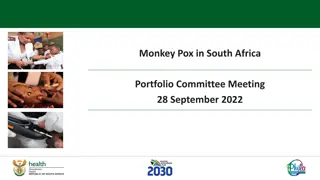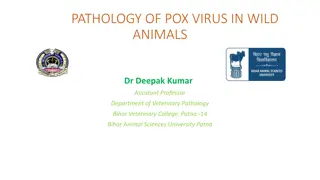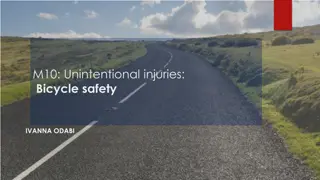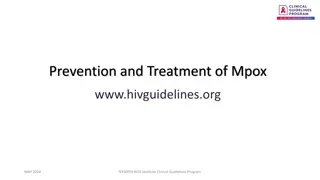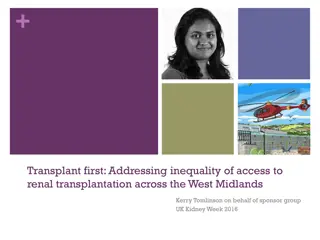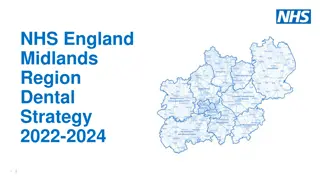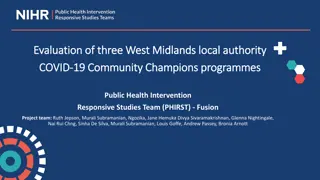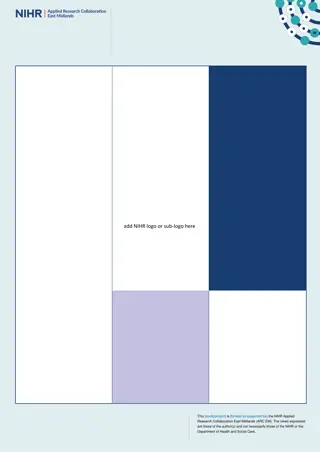Monkeypox Guidance for Midlands Region: Overview and Safety Measures
Monkeypox is a rare zoonotic virus with similarities to smallpox but lower mortality. The virus spreads through close contact and has an incubation period of 5-21 days. Symptoms include fever, rash, and malaise. Treatment is usually supportive, but severe cases exist. Isolation and protective equipment are crucial in managing cases. Vaccination and post-exposure prophylaxis are important preventive measures. Proper PPE, including gowns, respirators, and gloves, is essential when caring for patients. Close contacts must isolate, and staff without appropriate PPE may need to isolate as well.
Download Presentation

Please find below an Image/Link to download the presentation.
The content on the website is provided AS IS for your information and personal use only. It may not be sold, licensed, or shared on other websites without obtaining consent from the author.If you encounter any issues during the download, it is possible that the publisher has removed the file from their server.
You are allowed to download the files provided on this website for personal or commercial use, subject to the condition that they are used lawfully. All files are the property of their respective owners.
The content on the website is provided AS IS for your information and personal use only. It may not be sold, licensed, or shared on other websites without obtaining consent from the author.
E N D
Presentation Transcript
Monkeypox Guidance NHSEI Midlands Region 20220525 Version 1.2 NHS England and NHS Improvement
Introduction Monkeypox is a rare zoonotic virus that is not easily transmissible between people. Monkeypox is similar in presentation to smallpox, however there is significantly lower mortality rate, the current cases identified in the UK are from the West Africa clade which has a reported mortality rate of 1%. Transmission It is spread through close contact with an infected/contaminated animal, human or material entering through broken skin,(even if not visibly broken), respiratory tract or mucous membranes. Person to person spread may occur through; direct contact with monkeypox skin lesions or scabs, contact with clothing or linens used by an infected person Respiratory transmission can occur through coughing or sneezing of an individual with a monkeypox rash. The incubation period is between 5 and 21 days (average 6 16 days) Clinical presentation The illness begins with Fever, malaise, lymphadenopathy and headache. 1 5 days after the fever a rash develops, this often begins on the face or genital area and then spreads rapidly across the body. The rash goes through various stages before forming a scab which falls off. People are infectious from the prodrome until healthy skin has developed under the scabs. The illness usually lasts 2-4 weeks 2 | 2 |
Introduction Treatment: The illness is usually self-limiting and most people will recover within several weeks, however severe illness is known to occur. There are is a licensed medicine (Tecovirimat) for use in USA and Europe, however this is not yet authorised by MHRA. Isolation Close contacts are currently expected to isolate for 21 days following exposure. Staff who are not wearing the correct PPE when in contact with cases who are later confirmed as positive will also be asked to isolate for 21 days Vaccination of high risk contacts has now commenced. Vaccination for post exposure prophylaxis is most effective if given with 4 days of exposure to prevent onset of disease, however can be given up to 14 days post exposure to reduce severity of disease if required. 3 | 3 |
Personal Protective Equipment (PPE) The following PPE is required when providing care for the patient and when in contact with the environment: For all patient care activities (triage, testing, direct clinical care, cleaning of the environment, vaccination): A disposable, fluid-resistant gown or coverall A disposable, fluid-resistant apron (standard length) worn over the gown (personal preference, not mandated) A FFP3 respirator or hood (fit-tested and fit-checked) A full face visor Single pair of disposable gloves In the event that the correct PPE (as above) is not worn a risk assessment needs to be completed by the Organisation to determine if the individual needs to isolate. It is likely that if there is a requirement for staff who are not wearing PPE to isolate until the results are back (if negative) or for 21 days following exposure. All staff who require FFP3 respirator should be fit tested to the mask that they are using. Fit testing should be completed for each type of mask that is used by the member of staff. Fit testing should be completed on a two yearly cycle or if the member of staff gains/loses weight which will effect the fit of the mask, if the staff member has dental work or surgery which alters the shape of their jaw. 4 | 4 |
Process For PCR Swabs Where Monkeypox is suspected, Doctors in either Primary or Secondary care should contact the Imported Fever Service on 0844 7788990 to discuss the need for a Swabbing (PCR). Please ensure you have the following information when calling; Patient identifiers Full travel history including Dates and locations of travel Activities/exposures Vaccination/prophylaxis Clinical details and past history If you are advised to send samples for testing by the Rare and Imported Pathogens Laboratory (RIPL) a referral form P1 SPATHW039- 04.qxp (publishing.service.gov.uk) will need to be completed. Once completed, the sample and referral form should be sent by courier to; Imported fever service c/o Rare and imported pathogens laboratory (RIPL) Public Health England Manor Farm Road Porton Down Wiltshire SP4 0JG It is the referring providers responsibility to arrange the courier for Immediate transfer to the IFS address at Porton Down Positive results are phoned immediately to the referring clinician to support timely patient management, infection control and public health response. 5 | 5 |
Clinical Commissioning Groups / Integrated Care Systems Where a call is received to confirm a suspected monkeypox case, the following needs to be confirmed; If the patient is isolated in a negative or neutral pressure room with en- suite facilities, and appropriate PPE is being used in line with HCID practice Ensure escalation to NHSEI on call takes place notifying of suspected Monkeypox case Confirm that a Polymerase chain reaction (PCR) has been sent to UKHSA and the time it s due back Contacts: UKHSA health protection teams - GOV.UK (www.gov.uk) Contacts: UKHSA health protection teams - GOV.UK (www.gov.uk) Also notify the Local Health Protection Team Contacts: UKHSA health protection teams - GOV.UK (www.gov.uk) If confirmed as a positive Monkeypox case, confirm the following: That the organisation continues to isolate the patient and will need to do so until further notice Confirm that all staff involved in patient care have been identified and details logged for follow up, including PPE worn during interaction with patient Should a patient become unwell during isolation this should be immediately escalated to Regional NHSEI on call, for urgent consideration Accurate records/notes should be made and maintained as per the CCG/ICS records management policy 6 | 6 |
Clinical Commissioning Groups / Integrated Care Systems (Cont d) Where the patient is to be transferred to a High Consequence Infectious Disease (HCID) Centre or Infectious Disease (ID)Centre, this decision will be made and communicated by National NHSEI team For confirmed transfers, NHSEI first on call will host a conference call to confirm; - Host trust - Receiving trust - Ambulance trust(s) involved in the transfer The call will aim to confirm; - Likely pick up time for ambulance service - How to access patient and return to the vehicle, including where to meet escort if patient is not in an immediately accessible area - Arrival times including any monitoring arrangements Consider if patient removal will impact on host organisation s ability to manage media or clinical capacity during this time. Accurate records/notes should be made and maintained as per the CCG/ICS records management policy 7 | 7 |
Community Pharmacy/Other Community Setting Patient presents at clinical setting with suspected monkeypox Prior to any patient contact, Don Appropriate PPE Immediately move patient to an isolated clinical assessment area History taking and examination should be undertaken 1m away from the Patient where possible Clinical history and or presentation suggestive of Monkeypox Arrange Ambulance transport via 999, advising suspected Monkeypox Isolate Patient within Assessment room until Ambulance Arrival Decontaminate All Contact Areas, As per IPC guidance The latest guidance for environmental cleaning and decontamination can be found Monkeypox_Guidance_Cleaning_Decontamination v2 (publishing.service.gov.uk) 8 | 8 |
General Practice Where patients contact the surgery or NHS 111/OOH suggesting Monkeypox, stay at home advice should be given where someone will contact the patient. Patients should not be advised to attend the surgery or clinical setting with suspected Monkeypox Patient self presents at clinical setting with suspected monkeypox Don Appropriate PPE Isolate the patient History taking and examination should be undertaken 1m away from the Patient where possible Clinical history and or presentation suggestive of Monkeypox Discuss patient presentation with the Imported Fever Service (IFS) on 0844 7788990 to understand the requirement for a swab and next steps Contacts: UKHSA health protection teams - GOV.UK (www.gov.uk) Contacts: UKHSA health protection teams - GOV.UK (www.gov.uk) Also notify the local Health Protection Team Contacts: UKHSA health protection teams - GOV.UK (www.gov.uk) Where required, Swab Patient (Polymerase Chain Reaction [PCR]), and follow guidance in slide 5 Arrange Ambulance transport via 999 or Urgent Care transfer (Urgency dependent on patient presentation), advising suspected Monkeypox. Patient to remain isolated at the surgery/clinical setting Decontaminate all contact areas, as per IPC guidance The latest guidance for environmental cleaning and decontamination can be found Monkeypox_Guidance_Cleaning_Decontamination v2 (publishing.service.gov.uk) Monkeypox_information_for_primary_care (publishing.service.gov.uk) 9 | 9 |
Acute Trust Patient presents at clinical setting with suspected monkeypox Don Appropriate PPE Move Patient to a negative or neutral pressure room with en-suite facilities for further assessment History taking and examination should be undertaken 1m away from the Patient where possible Clinical history and or presentation suggestive of Monkeypox Discuss patient presentation with the Imported Fever Service (IFS) on 0844 7788990 to understand the requirement for a swab Contacts: UKHSA health protection teams - GOV.UK (www.gov.uk) Contacts: UKHSA health protection teams - GOV.UK (www.gov.uk) Also notify the local Health Protection Team Contacts: UKHSA health protection teams - GOV.UK (www.gov.uk) Where required, Swab Patient (Polymerase Chain Reaction [PCR]) , and follow guidance in slide 5 Results returned after 17:00 daily, national HCID clinical review undertaken 10:00 daily to confirm next steps for positive patients. Outcome to be fed back to acute Review patient care pathway for a) hospital admission (In conjunction with NHSEI) or b) isolation at home/virtual ward arrangement Ambulance transfers, where required, to be coordinated by NHSEI and NARU Decontaminate All Contact Areas, As per IPC guidance 10 | 10 |
Ambulance Service Community Setting Call Received from Primary Care or other Community Setting indication a suspected Monkeypox case Or Clinician on scene identifies possible Monkeypox case Don Appropriate PPE Clinical history and or presentation suggestive of Monkeypox Where attendance is to a none residential location (Primary Care, UTC etc.) the attending crew should contact their local receiving Infectious disease centre, alerting to a possible Monkeypox case being transferred to them. On arrival at the ID, non-attendant crew member should make contact with the ID Team, notifying of arrival. The attending crew should be directed to the negative or neutral pressure room Decontaminate All Contact Areas, As per IPC guidance 11 | 11 |
Ambulance Service Transfer to HCID/ID Centre Call Received from NHSEI requesting a transfer to a HCID/ID Centre for a suspected or confirmed Monkey Pox Case Confirmation received of the HCID/ID Centre destination HART Team to mobilise to patient Crew to Don Appropriate PPE Attending crew to receive full clinical handover, with associated clinical notes. Transfer of Care from hospital to Ambulance Crew takes place Transport of patient to HCID/ID takes place. Should the patients condition deteriorate, requiring of diversion to nearest ED. Attending crew will contact nearest ED, pre-alerting to the patients condition and Monkeypox status. On arrival at the HCID/ID or ED where diversion has been required, non- attendant crew member should make contact with the ID Team, notifying of arrival. Decontaminate All Contact Areas, As per IPC guidance 12 | 12 |
Monkeypox 23/05/2022 Monkeypox guidance can be found below, this was last updated on 21/05/2022 Monkeypox - GOV.UK (www.gov.uk) Case definitions were updated on 21/05/2022, the lastest version can be found here: Monkeypox: case definitions - GOV.UK (www.gov.uk) Contact tracing guidance was updated on 21/05/2022 Monkeypox: contact tracing - GOV.UK (www.gov.uk) Vaccination guidance was updated on 21/05/2022 Monkeypox vaccination - GOV.UK (www.gov.uk) The latest guidance for environmental cleaning and decontamination can be found Monkeypox_Guidance_Cleaning_Decontamination v2 (publishing.service.gov.uk) IPC guidance is in development by the national IPC team with support from regional colleagues. Additional resources have been produced by the British Association for Sexual Health and HIV (BASHH) Monkeypox Resources | British Association for Sexual Health and HIV (bashh.org) 13 | 13 | Presentation title
